The information and communication technology sector has witnessed unprecedented growth in the last decade across the world. Increased penetration of electronics in everyday products and increased adoption of electronics products by people have fueled this tremendous growth. Increased consumer demand has also resulted in increased investment in product innovation, leading to shorter life-cycle of products. Over time, this has resulted in the rapid generation of a voluminous amount of electronic waste (e-waste).
E-waste is now the fastest growing waste stream, with computer equipment accounting for almost 70 per cent of it, followed by telecommunication equipment (12 per cent), electrical equipment (8 per cent) and medical equipment (7 per cent).
E-waste, needless to say, represents an enormous environmental hazard. However, it also presents huge opportunities for entrepreneurs willing to take the plunge. According to a recent study by Assocham-Ckinetics, India is the fifth largest e-waste producer and its e-waste generation is expected to annually grow at 30 per cent to touch 5.2 million metric tonnes (MT) per annum by 2020 as against the present level of 1.8 million metric tonnes. This, in turn, represents a huge business opportunity in e-waste recycling.
This project report provides a brief overview of e-waste recycling business requirements.
E-waste recycling process
E-waste recycling is highly labour-intensive and involves several steps starting from waste collection to final material processing (Fig. 1) in order to obtain the desired recycled products or raw materials for reuse.
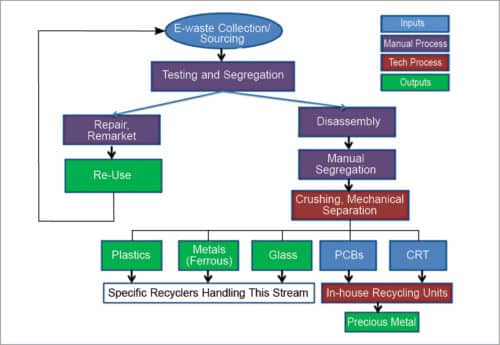
Different types of e-waste materials and processes used for their management are laid out in Table I. The different valuable metals obtained after processing are given in Table II.
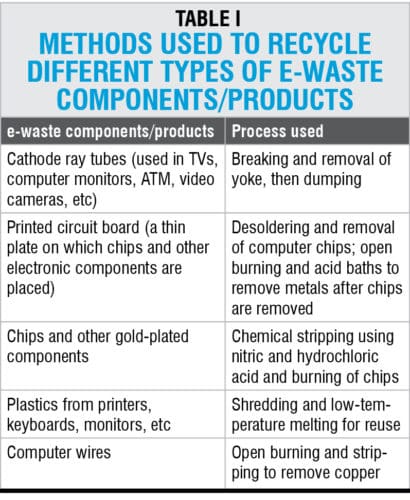
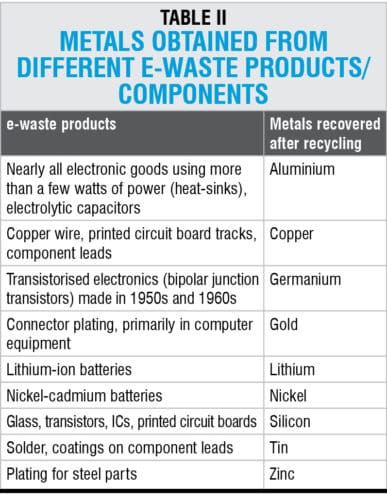
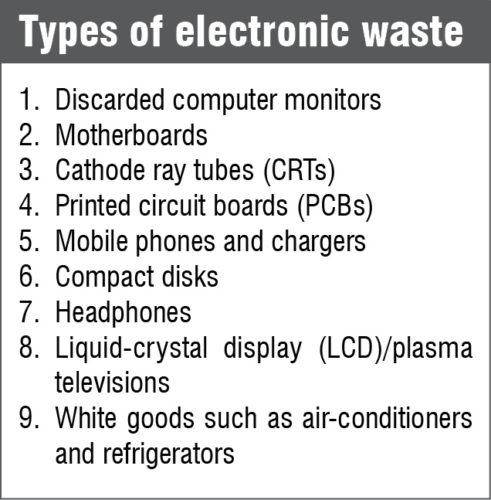
Business economics
e-waste business models include:
1. Franchisee-based operation: Waste management as a franchise unit of an already established e-waste management company
2. Self-owned operation: Waste management through purchase of waste from various sources
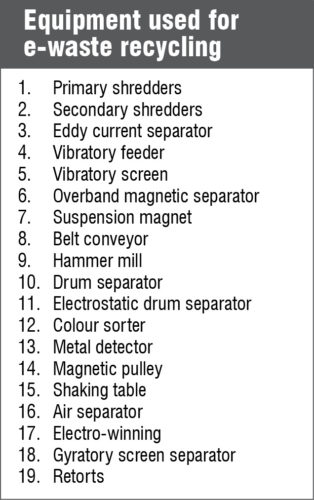
The franchisee model is suitable for investors who are looking for a business opportunity with low investment threshold. In this model, the franchisee unit could benefit from some of the parent company’s infrastructure. Hence the capex and opex requirement is lower than for the self-owned business model. In the self-owned business model, the entrepreneur needs to bear the entire investment cost himself.
It’s not possible to provide economic analysis of the franchisee model as it depends on the terms of agreement. However, typical requirements for starting a franchisee unit with a capacity to mobilise 60MT e-waste products per annum are:
1. Investment: ₹ 700,000-800,000
2. Area: 93-139sq.m (1000–1500sq.ft)
Under the self-owned model, a business unit capable of revenue generation to the tune of 6.0-7.5 million rupees per month (that is, processing of at least 500kg e-waste per day) are given below:
Capital expenses
1. Land: 1858sq.m (20,000sq. ft) to start with
2. Plant and machinery: 3.5 million rupees
Operational expenses
Approximately 4 million rupees per month
Operational expenses include:
1. Human resource cost
2. Cost of scrap
3. Expenses on utilities such as electricity and water
4. Logistics expenses
5. Marketing expenses
6. Spares and consumables
7. Contingency expenses
Detailed business economics, including estimated value against the above-mentioned cost heads and other probable cost heads, along with profit analysis and breakeven point (BEP) calculation can be worked out based on the desired scale of operation.
Revenue calculation for recycling of 1-tonne personal computer (PC) e-waste
1. PC e-waste: 1 tonne
2. Number of PCs: 38 (assuming that each PC weighs 28kg)
Scenario 1: Complete PGM recovery
Recovery of the precious platinum-group metals (PGMs) from PCBs is the main recycling revenue generator (refer Table III).
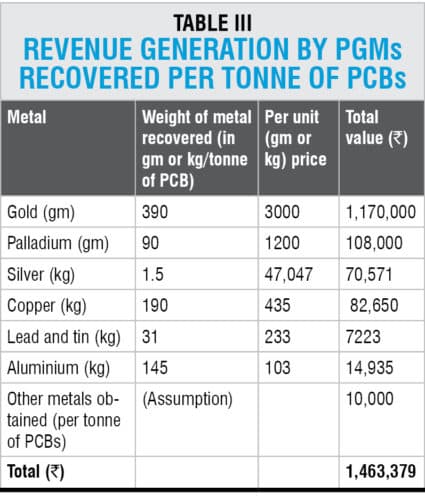
PCB constitutes almost 4 per cent of a personal computer (PC).
Amount of PCBs recovered from one tonne of PC waste=Around 40kg (0.04 tonne)
Therefore, revenue generated from one tonne of PC waste= ₹ 1,463,379×0.04= ₹ 58,535
Revenue generated per kg of PC waste=Around ₹ 58
Scenario 2: Partial PGM recovery and repair to resell
Thirty-five per cent of the waste PC units are repaired and resold at the rate of ₹ 2500 per PC. Both these assumptions are conservative. The remaining 65 per cent is recycled as mentioned in Scenario 1.
Therefore the number of units repaired=13 (35 per cent of total number of units)
Total resale price= ₹ 2500×13= ₹ 32,500
Total value of PGM recovered from 65 per cent recycling= ₹ 38,047
Total revenue from one-tonne PC e-waste= ₹ 32,500+ ₹ 38,047= ₹ 70,547
Revenue generated per kg of PC waste=Around ₹ 70
Therefore repair-and-resale model earns around 22 per cent higher revenue.
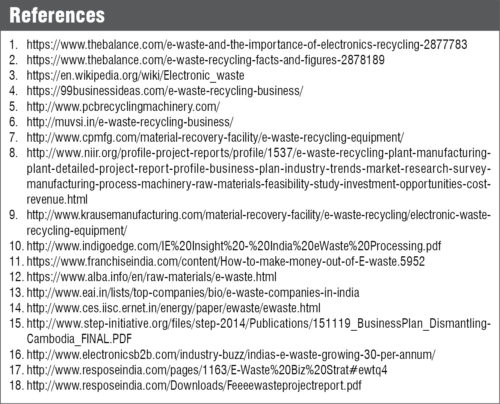








Hi, Thanks for an insightful article. I would be interested in setting up a self owned E Waste recycling plant. It would be great if you could connect me to some E Waste consultants that can help in setting up of the same.
If you would like to move forward with your plan to setup your own recycling/dismantling plant in any part of India, please feel free to contact us at [email protected]
Hi
Any one of you have started this plant.
If yes plz provide your consultants at [email protected]
mr.sahil
i am also wish to start it. we may talk.
please write me.
I would be interested in setting up a ewaste Dismantling unit. Let me know if anyone can help understand the costs etc
Hii.Thnks for ur brief about Ewaste along with recycling.I am interested as an entrepreneur to work with this.I will be thankful if u guide us to move in Bihar.
Thankuu..
please guide me for setting up my own business plant.pune
Sir i m interest to work with ur franchise before that i want to visit ur side so i get better idea of project. can u arrange i m from mumbai so if u have ur segregation plant near me i will visit it.
Thank you so much for explaining this topic is such a simple and easy to understand way. Looking forward to hear a reply from you brother.
[email protected]
Pl guide me to start my own e wast recycile plant
Let me know if any one is interested to partner with me on setting up E-Waste plant.
thanks
Hello Rajesh,
where are you from and where you do you want to setup this business?
Please write – [email protected]
Please i need guidance… i need to start e waste management bussiness…
Hi
I would be interested in setting up an e waste unit in Bangalore. Please let me know any contacts regarding the same.
Dinesh
Hi,
I am willing to start something in this lines of e-waste management with limited investment. Would be really helpful if you can guide. Also, if you can advise on the plant and machinery cost.
Thanks
Dharmesh
Im willing to start e-waste recycling business in Gujarat.can you provide me more information about plant setup and other legal procedures ?
I am willing to start e-waste management with limited investment. Would be really helpful if you can guide. Also, if you can advise on the plant and machinery cost and liecences
Hi,
I would be interested in setting up an e waste unit in Bangalore. Please let me know any contacts regarding the same.
I am also interested in this concept
Hi,
Please contact us at [email protected] for waste management setup and any other related consultancy.
Sir I am interested to setup for waste management,please guide on me on [email protected]
I am Mrs.Sunayana having interest in e- waste management setup in Ambernath Dist: Thane
can I get at least 3 to 4 contacts for guiding purposes.
Whats process, cost and statutory requirement for E-waste plant.
Sir I am interested to take license for E-scrap items and setup for waste management,please guide on me on [email protected] – How to get the License for E-scrap?
Hello sir, Thanks for an informational article. I would be interested in setting up a self owned E Waste recycling business. It would be great if you could connect me to some E Waste consultants that can help in setting up of the same.
Reply
Hi,
This is very insightful information. I would like to start up an e-waste disposal and recycling plant. I need your guidance.
Thank you
Dear Samuel,
For any further queries, write us at [email protected]
I would like to get information on how to proceed with a e-waste management facility. I have a commercial land and would like to go with the franchise model. Please guide me in this regards.
Thank you